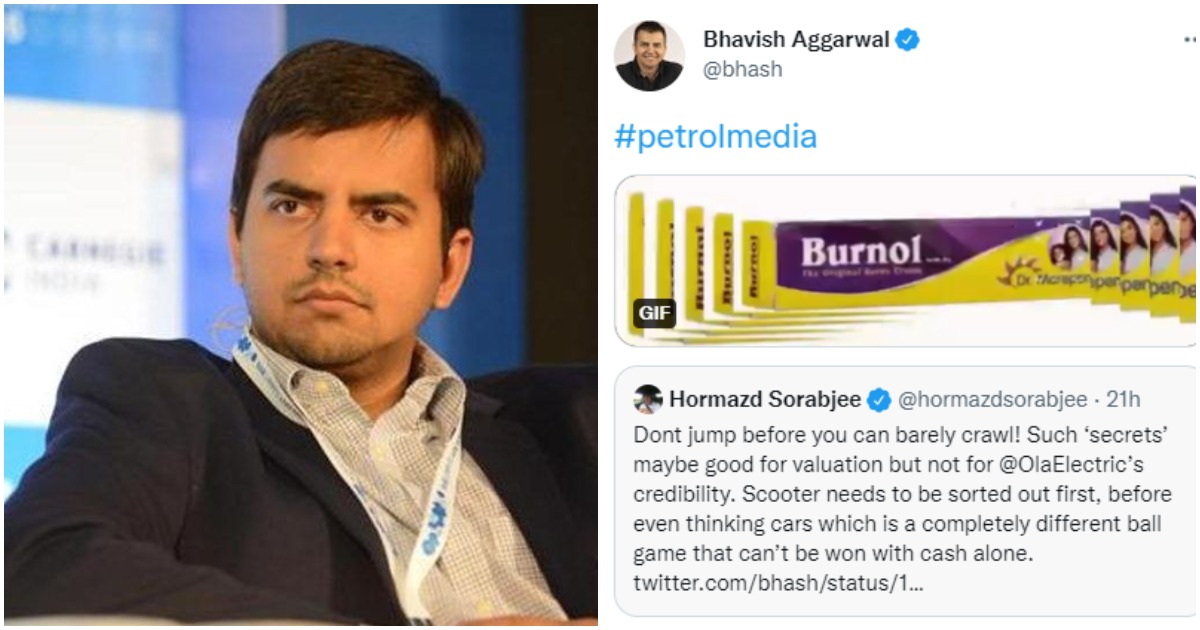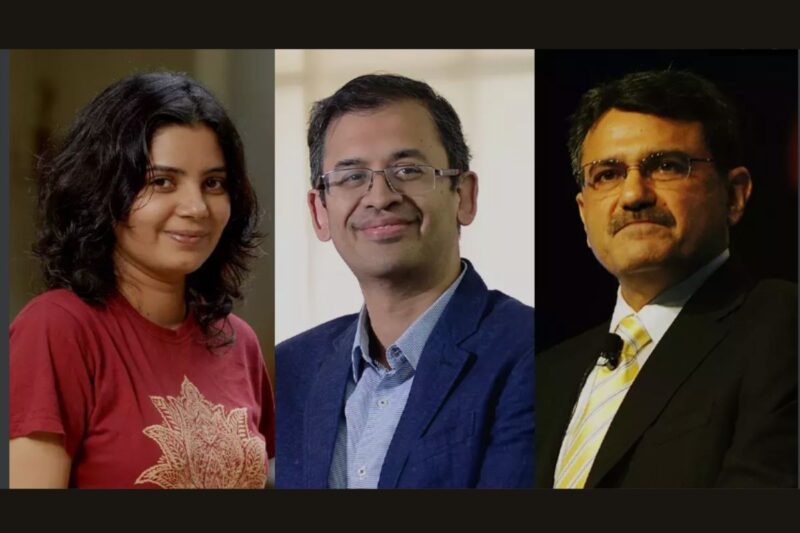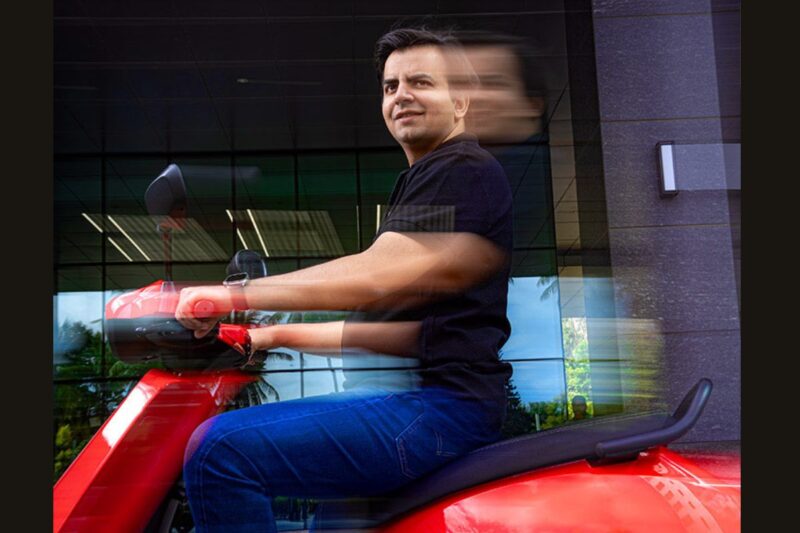Ola Electric IPO: Should It Be Given A Green Signal Keeping In Mind The Internals Of The Firm, Funders And The Founder?
Ola tries to jump into every domain that revolves around the time of the moment but may or may not successfully reach the last point. Ola Café, Foodpanda, Ola Cars and Ola Dash show that the founder jumps into every new domain without assessing their competency to dig deeper into that.

It’s not been a month since we witnessed the fate of Mamaearth IPO, and the internet flooded with the release of another VS-funded IPO. This time, it is Ola Electric. As Ola Electric became a public entity, news is hovering that it is going to file DRHP for its upcoming IPO in the new year. Electric Vehicles, particularly two-wheelers in India, have seen an upsurge in sales for quite a time; this, however, doesn’t imply a successful landing on Indian roads, as they carry with themselves their own set of hurdles, which cannot be ignored.
Moreover, a company like Ola, which primarily hails a ride-booking business with no or little expertise in the EV manufacturing business, comes into the sector and creates a buzz of being successful and launching an IPO. In such circumstances, is Bhavish Aggarwal’s Ola Electric competent enough to launch an IPO and protect the retail investor’s money through its exclusive business model, or will it see the same fate as those of Nykaa, Paytm, Zomato, and the latest one, Mamaearth?
Along with Business models, we are going to discuss the Founder, Bhavish Aggarwal, as well because it is the founder whose perspective and vision define the success of the organisation.
The founder’s oh-so casual, hurried and freckled attitude on the professional front.
There is nothing new about electric vehicles catching fire- The shocking statement in favour of Ola Electric.
Amidst electric vehicles, particularly electric scooters, catching fire in several areas of the country, Ola founder and CEO Bhavish Aggarwal made an unexpected comment in June. He asserted that Electric vehicles (EVs) will catch fire, which will also occur in vehicles manufactured by multinational firms. This was after a Tata Nexon EV blaze in Mumbai’s Vasai. However, this is not the first time Aggarwal has used social media to mock EV sceptics. He had previously engaged in a Twitter spat with numerous people.
Aggarwal presented a snapshot of an electric car in a tweet a few months ago, hinting about the company’s forthcoming EV. However, several individuals asked him to solve the problems with the Ola electric scooters. Afterwards, Aggarwal used the hashtag “#petrolmedia” and posted a photo of Burnol. It seems that Mr Agarwal is heading towards a battle with ICE engines. This comes from his statement, “If they have OATS for breakfast, I put ICE cubes in my drink‘; as said against Bajaj Auto MD’s statement from October 2021, where this one mentioned ‘We are champions… Champions eat OATS’.

If you didn’t understand this and were confused about why we headed towards food from electric vehicles, here is the answer. Bajaj Auto MD took a jibe at EV manufacturers in October 2021 while rolling out the Pulsar 250, saying they are champions and eat OATS (Ola, Ather, Tork and SmartE). In response to something asked to Mr Bhavish Aggarwal, he asserted witty that he put ICE( Internal Combustion Engines) into his drink.
This is quite sarcastic, as such a comment is not expected from either of the industry leaders. One has the point to tick out the shortcomings of another, but they can’t make such statements publicly. At this moment, it seems that our industry leaders are trying the attitude of our beloved ‘netas’, who may or may not do something productive for the nation but never leave any chance to put a black mark on the opposition.
Of course, the introduction of EV Will be a better option towards a greener nation, but it is not as easy as it seems to be, so instead of having a fight on Twitter or having a battle of words with the traditional players, the CEO should focus on the issues of manufacturing that has caused the electric vehicles into fires.
Also, after all these comments, it seems that the CEO, Bhavish Agrawal, tries to be the poster boy for everything he ventures into. Undoubtedly, his effort to launch Ola Cabs was a great effort and a competition to the hover; however, this time, it is different. There are bigger challenges accompanying electric and easy manufacturing. However, the difficulty for Ola Electric would be distinct from that of Ola Taxis. Cabs were limited to providing services, whereas Electric must deliver both services and products.
“Ola Electric needs to shift from being ‘the fastest’ to being ‘the only one,’ taking care of customer service and needs,” asserted brand strategist Harish Bijoor. He points out that Aggarwal has been the poster boy for mobility service and now mobility products.
There is nothing wrong in being the first face or the only face of a particular sector, but the problem is not addressing the consumer demands and giving such kind of Spontaneous statements about the safety of the vehicle implies and may resonate with a casual attitude of the founder towards His product. There is no doubt that electric vehicles may catch fire, but the security and safety of the consumer, along with the belief that the founder is addressing the demands of the customer, is very important.
The aggressive attitude of being over-ambitious- Seems like a jack of all trades and a master of….
As mentioned earlier, Ola tries to jump into every domain that revolves around the time of the moment but may or may not successfully reach the last point. Ola Café, Foodpanda, Ola Cars and Ola Dash show that the founder jumps into every new domain without assessing their competency to dig deeper into that. For example, Ola Café closed in early 2016, a year after its opening. Three years later, in 2019, Ola shut down Foodpanda, which it had purchased around the end of 2017. Ola shut down its used-vehicles business, Ola Cars, and its rapid commerce endeavour, Ola Dash, in June last year.

This shows Ola’s track record of exploring multiple things at multiple times and then eventually folding them up. The founder is surrounded by a promising start and a disappointing end, so the critics ask him to focus only on one business and become the biggest name in that, the core ride-booking business.
Also, now Mr Aggarwal is taking bold bets, and the empire of OLA is standing on four pillars- The first is the fundamental business, which is ride-hailing. Then there’s the electric business of producing EVs—two-wheelers, three-wheelers, and cars. The third is the cell business. Ola’s fourth vertical is a section dedicated to AI and silicon. “It’s called ‘Krutrim,’ which means ‘artificial’ in Sanskrit,” says Aggarwal, who adds that the business plans to introduce electric bikes next year.
Some businesses require shallow expertise, while others require deep knowledge. Ola is shifting from superficial to deep competence since its taxi service does not require the same level of expertise as its electric scooter company. In a deep competence field, rebuilding the team is critical for the company’s successful performance, and such turnover might be “a very big red flag.”
Though the rapid development and effect have been astounding, it is critical to maintain concentration when working in such a fast-paced environment, especially if one works in a hardware firm. Building hardware items, particularly in the automotive industry, takes years. And compromising on quality or ethics is not an option, although the company blog maintained that Ola never compromised on quality.
Aggarwal’s colossal aims necessitate a colossal budget. Aggarwal has thus far been successful in raising finance at high valuations for Ola Electric, which secured financing for the first time in early 2019. According to analytics firm Tracxn, it was valued at about 383 billion rupees in April 2022 and had investors such as Hyundai and Kia. ANI Technologies, Ola’s ride-hailing firm, was valued at 530 billion rupees 12 years after its inception. However, the flood of funding pouring into startups is a thing of the past.
As previously said, Ola has a habit of establishing new enterprises and quickly shutting them down. It dabbled in food and grocery delivery in 2015 before abandoning it a year later. It acquired Foodpanda from Delivery Hero in 2017, but it struggled to make a difference in a market dominated by Swiggy and Zomato. It shut down its rapid commerce and used vehicle operations earlier this year, both within a year of their inception.
Ola Electric was founded in 2017 with the intention of producing four-wheeler electric cars that would eventually replace the parent company’s petrol and diesel fleet of taxis. The pilot project launched by Ola Electric in 2017 sought to create “an electric mobility ecosystem at scale, comprising charging infrastructure and the range of vehicle fleet viz. electric cabs, e-rickshaws, electric auto-rickshaws and electric buses”. The initiative, however, did not take off since drivers returned cars due to excessive charges and unviable charging infrastructure.
Following that, the company changed its attention to the development of lithium-ion batteries. These batteries were to be sold on a pay-as-you-go model to three-wheelers in northern India, which has a huge fleet of electric vehicles powered by lead acid batteries. The business intended to have rickshaws switch batteries at various locations at Ola charging stations and wean them off lead-acid batteries.
Ola Electric was also developing its own electric three-wheeler and two-wheeler motor vehicles. As part of its “Mission Electric,” the firm stated in April 2018 that it will have 1 million Electric vehicles on platform by 2021. It intended to plan its EV development, including the construction of battery charging stations, using traffic patterns, efficient transit routes, and other important data from the core taxi company. Not only did the firm fall short of its 1 million objectives, but it also suspended efforts to develop the battery swapping business in 2020 when Aggarwal acquired sole control of Ola Electric. At the same time, it placed the three-wheeler project on hold.
Mr Agarwal, on his part, says that he follows his heart and DNA. He is an abroad perspective person, and he believes that one should explore in every domain; this is good in general, but doing this with the money of retail investors that is used to give success to the IPO may not be justified. There is no doubt that Ola Cabs built a local business model, local products, and local technology and emerged as the biggest player; however, the product industry demands a bit more R&D.
Also, why have we seen an exodus of top-level management from Ola, specifically when the left-out ones are the propellants of the business? Is it the onset of a Leadership Puzzle?
Ola has seen a huge turnover of key executives in recent years. According to estimations, about 16 top officials from different businesses, including Ola Cabs, Ola Cars, Ola Electric, and Ola Financial Services, have quit. These departures have left a leadership vacancy, making it much more difficult for Ola to strategize and handle the current quandary.
Dinesh Radhakrishnan, who dealt with engineering operations across both Ola Electric and Ola Cabs; Mr Arun Sirdeshmukh, head of the used vehicle business Ola Cars; Ola’s chief marketing officer Mr Varun Dubey and CFO Mr Swayam Saurabh; Ola Electric’s head of quality assurance Joseph Thomas; and Ola’s chief operating officer Gaurav Porwal are among those who have left the company in the last two years. Many have cited the company’s rigorous work culture as the reason for its ongoing turnover of personnel.
Another one, Aggarwal opted to focus all of Ola Electric’s resources on developing two-wheelers after halting the battery swapping and three-wheeler operations. Ola Electric’s co-founder Jain left the company a few months after Aggarwal took leadership and made significant modifications to its strategy. According to the sources, Jain had supported the battery-switching idea.
Prior to the IPO filing, the business saw the return of former group CFO Harish Abhichandani to an active position at Ola Electric. According to reliable sources, Abhichandani would be in charge of the financial department of Ola Electric. He was first hired back as the head of finance for Ola Electric’s automotive segment, but insiders suggested he would take over the whole finance division. According to one of them, Abhichandani is now identified as Ola Electric’s CFO in meetings with external organizations that assist Ola Electric with the IPO process.

Abhichandani taking over the financial function of automotive — Ola Electric’s sole operating business — that is, electric scooter manufacture and sales, is a significant organizational shift. This would imply that Abhichandani would take complete charge of Ola Electric’s financial operation. He will work directly with Aggarwal, according to many high sources, and all personnel of the financial section would report to him. It will be crucial to see if such an organisational shift will work in favour of the Ola empire or not!
Also, there is an anticipation that new people will join the board. Aggarwal is in the process of reconstituting Ola Electric’s board of directors by bringing in a number of independent directors. According to reports, former Airtel CEO Manoj Kohli, creator of Mensa brands Anant Narayan, and YourStory founder Shradha Sharma are all expected to join the board of Ola Electric. Previously, as SoftBank’s country head, Kohli advised SoftBank’s investee firms, including Ola Electric. Kohli, a seasoned business leader, now serves on the boards of various firms, including Bharti Broadband and WeWork India. Anant Narayanan, a McKinsey veteran and former CEO of Myntra, sits on the boards of many firms, including Marico and Birla Soft.
According to a data platform, Bhavish Aggarwal has been an investor in Sharma’s YourStory Media Private Ltd since 2019. The Company Act of 2013 requires public firms to include at least one woman on their boards. Sharma has a significant social media following and is a leading voice on startups and business. Aggarwal places a high value on media and communication. He is a frequent user of social media.
Ola Electric has built its brand mostly via digital marketing and communication. However, there has been historical evidence that the startups that rely majorly on advertising and marketing witness huge cash burns. The company’s spending on advertising and promotions surged 89% to Rs 255.65 crore during FY22. Ola’s outstanding losses surged to Rs 19,474 crore during FY22.

Questions regarding transparency.
Ola’s lack of transparency in terms of ownership has also sparked debate. Ola Electric was founded in February 2017 as a 100 per cent EV subsidiary by Ola (ANI Technologies, which owns India’s largest cab aggregator company). According to paperwork filed by the firm with the Registrar of Companies, on 19.02.2018, Aggarwal purchased 9,250 shares from ANI Technologies for Rs 10 apiece, giving him a 92.5 per cent stake. Aggarwal then transferred 2,185 shares to Indus Trust and OEM Employees Welfare Trust in January 2019, reducing his holding to 70.7 per cent, while ANI Technologies held 7.4 per cent.
A month later, Ola Electric secured Rs 306.2 crore ($42.2 million) in the Series A round from Matrix Partners, Tiger Global, and Sarin Family India LLC at a value of Rs 1,789.9 crore, reducing Aggarwal’s shareholding to 57.7 per cent. After collecting $250 million from SoftBank, the firm became a unicorn in July 2019 despite not producing or delivering a single EV. As of April 2022, Aggarwal controlled 36.6 per cent of Ola Electric and 8.7 per cent of ANI Technologies following a series of cash rounds.
Some observers wonder how investors in the parent business (ANI Technologies) got on board with him buying the firm’s ownership in a subsidiary for a modest price and then raising large sums of money. “Ola was in the cab aggregator industry as a firm. So, why are resources being invested in establishing the EV factory?
The firm for which you are well-known and are seeking funds is distinct from the business for which you want to conduct EVs. Nobody knows when the business changed and why shareholders of this firm that is going public (Ola Cabs) are not shareholders of that company (Ola Electric). On the anticipated Ola Cabs IPO, Arun Kejriwal, Founder of Kejriwal Research and Investment Services, said, “There’s a lot of ambiguity here.”
Kejriwal also questioned why money is needed to fund an asset-light firm (Ola Cabs) that is no longer burning money: “Why can’t it operate a business without asking for the amount of money it has? It is causing concern in the market. There must be a separation of the two firms’ ownership. Anyone fresh who comes in will bear the brunt of the punishment. “These startup IPOs will face increased scrutiny,” he predicts.
Is the time good for an IPO?
Ola Electric intends to register for an IPO before the end of this month. Aggarwal intends to float Ola Electric before the April 2024 general election. Keeping this in mind, he has been urging his staff to submit the DRHP before the end of this month. The market regulator, SEBI, typically takes three to four months to approve an IPO once a business applies for one. Agarwal expects that the groundwork for an Ola Electric listing will be in place by the end of March and that he would be able to take advantage of the brief window before the general elections in mid-April to make his market debut.
According to reports, the chances of making it before the elections are limited. Ola Electric will most likely have to time its public listing after the May-June 2024 national elections. Furthermore, the leadership believes they will most likely miss the November end date for filing that they have set for themselves.
On the supply side, some firms are exploring IPOs as a preferred exit strategy for their investors. On the demand side, the outcome of the next state elections and the general election would have an influence on overall market mood and, as a result, the main market,” said Pranav Haldea, managing director of Prime Database Group. The primary market has usually been relatively uninteresting in the run-up to elections over the last 25 years, Haldea remarked. According to analysts, the outcomes of state elections beginning in December will drive mood and may provide a preview of how the general election will play out.
Conclusion.
For all the years it has put behind it, the cab aggregator business in India has remained an extremely difficult place to generate money. Ola, as the uncontested market leader, confronts the enormous responsibility of steering the market to a sustainable route despite the fact that many of the promises made when these businesses joined have yet to materialize.
It’s realistic to argue that enormous gaps exist in terms of decongestion of highways, cutting pollution, giving dependable transportation options, and providing meaningful jobs to thousands of driver-partners. The market has also altered dramatically with the arrival of newer businesses like Blusmart, which has gone all-electric with the goal of developing and operating a charging network to covet by the time EV penetration reaches considerable levels in 2025 or so.

Bhavish Aggarwal’s bravado belies the difficulties his dream firm, Ola Electric, is facing. Even as consumer complaints, product issues, and senior management turnover increase, Aggarwal sees them as unavoidable ripples in a revolutionary business model. Will Ola Electric be remembered as a trailblazer or just another excellent idea?
To be sure, with EV sales expected to skyrocket in the next years, the industry is up for business. The benefits will be substantial, as the EV victors may become the new auto titans of the future. That’s why, for the time being, everything else—a high turnover of top executives, repeated pivots, investor concerns, and negative press—is unimportant to Aggarwal, who believes in his own capacity to deliver.




